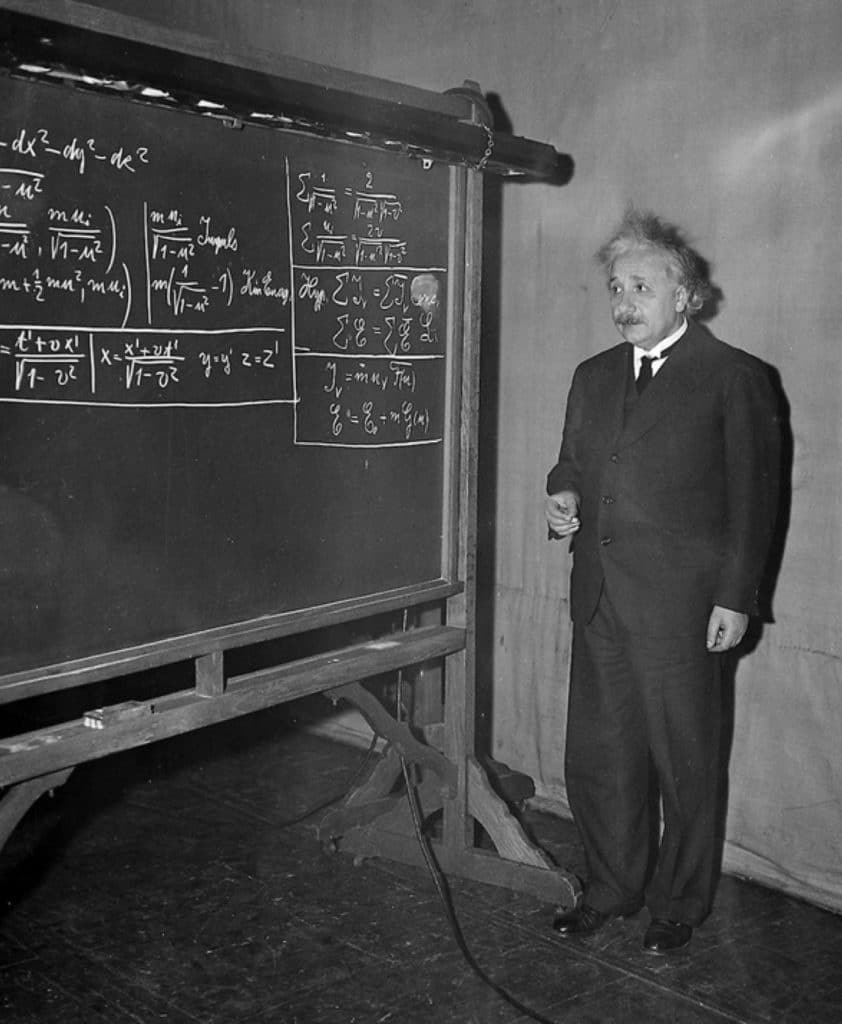
Perhaps, the best description of the difference between high intelligence and genius was captured by philosopher, Arthur Schopenhauer in his famous quote, “Talent hits a target no one else can hit; genius hits a target no one else can see.”
Einstein’s theories, for the most part, did not build upon previous theories in the evolutionary way that scientists typically extend human knowledge. His theories were revolutionary rather than evolutionary, because they were founded on new axioms that created new paradigms. For example, during his early study of physics, Einstein recognized that there were some asymmetries in Maxwell’s equations for electromagnetism. He noted that the current generated in a stationary coil of wire by a moving magnet was calculated differently from the current generated by a moving coil of wire around a stationary magnet. He realized that if motion is relative, then these two scenarios should be indistinguishable, because the laws of physics must be the same in all systems moving uniformly with respect to each other, i.e., in all non-accelerating systems. Einstein captured this idea in his first postulate of Special Relativity.
Postulate 1: No experiment can be performed that will detect an absolute velocity through space.
However, Einstein was troubled by an apparent contradiction that would result from his first postulate. He imagined a beam of light traveling at a speed c along a track and whizzing past a train moving at uniform velocity v in the same direction. An observer on a railway platform would measure the speed of light as c while a passenger on the train, would measure the light whizzing past at a speed of c – v. By comparing her measured speed to c, the passenger would be able to detect her absolute velocity, thereby violating the first postulate. To resolve this paradox, Einstein added the following second postulate.
Postulate 2: The speed of light is independent of the speed of its source (and the speed of its observer relative to the source).
This meant that the woman on the train speeding along the track at velocity v would measure the speed of light as whizzing past her at velocity c, no matter how great her velocity. Such a scenario is counter intuitive, because we know that the velocity of a boat moving downstream with velocity u (relative to the water) on a current of velocity v (relative to the shore)has a velocity of u + v relative to shore. As Bertrand Russell remarked:
Everybody knows that if you are on an escalator, you reach the top sooner if you walk up than if you stand still. But if the escalator moved with the velocity of light, you would reach the top at exactly the same moment whether you walked up or stood still.
If both postulates were to remain true, this would imply that time is not absolute and would be measured differently by observers moving at different speeds relative to one another. Faced with this counterintuitive consequence of these two postulates, most highly intelligent scientists would turn tail and run to the safety of the universally agreed concept of absolute time. However, Einstein was prepared to proceed wherever his inquiry would lead him–he trusted his instincts, once announcing, “Imagination is more important than knowledge.” Deriving equations of motion that followed logically from these two postulates resulted in his revolutionary Theory of Special Relativity– later verified experimentally by comparing the rate of decay of mesons at rest with their rate of decay at velocities close to the speed of light. Public verification of his mass-energy equation, E = mc^2, derived from his Special Theory, would become evident to the general public with the creation of the atomic bomb.
As his Special Theory of Relativity was yet to be accepted by the scientific community, Einstein pursued his General Theory, which discarded the assumption that we live in what geometers call a “Euclidean space” in which parallel lines never meet. Einstein proposed that around large masses space has the properties of a non-Euclidean geometry (often described as “curved space”). This meant that Newton’s formulation of gravity as an invisible force pulling masses together, was reformulated as a curvature of space around large masses. Consequently, photons of light, having zero rest mass would follow a curved path around the sun when passing from a star to earth. Observing such a deviation could only be done during an eclipse of the sun.
On November 6, 1919, at a joint meeting of members of the Royal Society and the Royal Astronomical Society the photographs and measurements from Eddington’s expedition to Principe Island, where the solar eclipse was observed, were presented. With all the pomp and circumstance of formal British society, Astronomer Royal, Sir Frank Dyson announced, “After a careful study of the plates, I am prepared to say that there can be no doubt that they confirm Einstein’s prediction.” J. J. Thomson, discoverer of the electron, asserted, “The result is one of the greatest achievements of human thought.”
Einstein’s conjectures had been verified and his theories were eventually accepted. These were two remarkable new paradigms that changed the direction of physics and opened the door to new discoveries by others. Einstein made several other remarkable contributions to physics that I have documented in more detail in other posts and in my books on intelligence, but these breakthroughs in his theories of relativity are the discoveries that qualify him as the quintessential genius of the 20th century.
